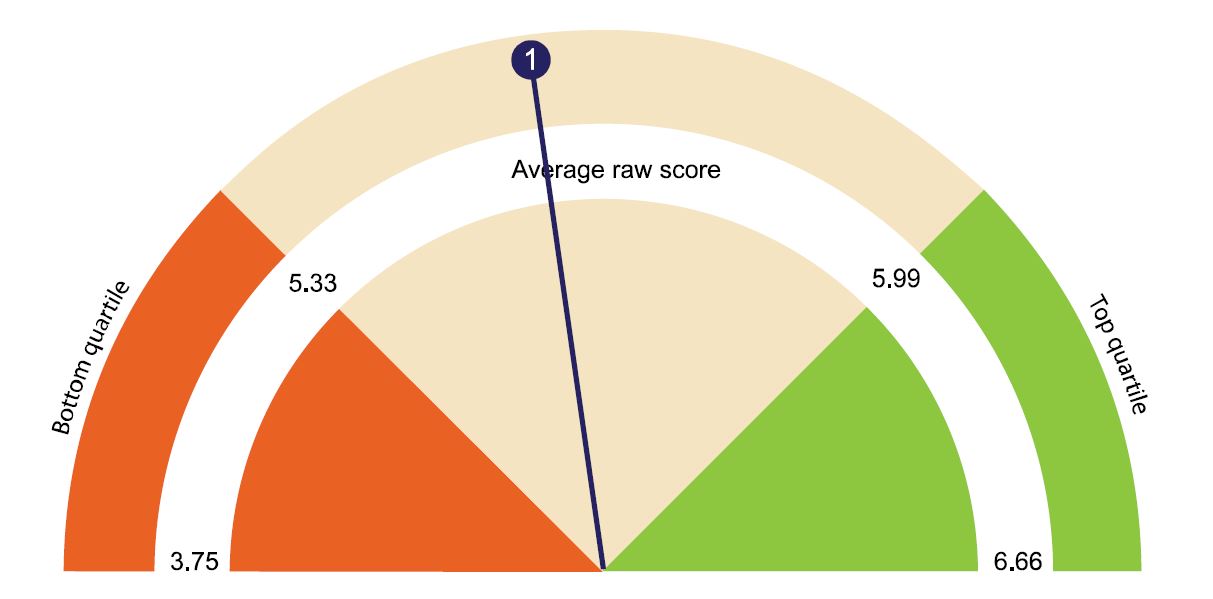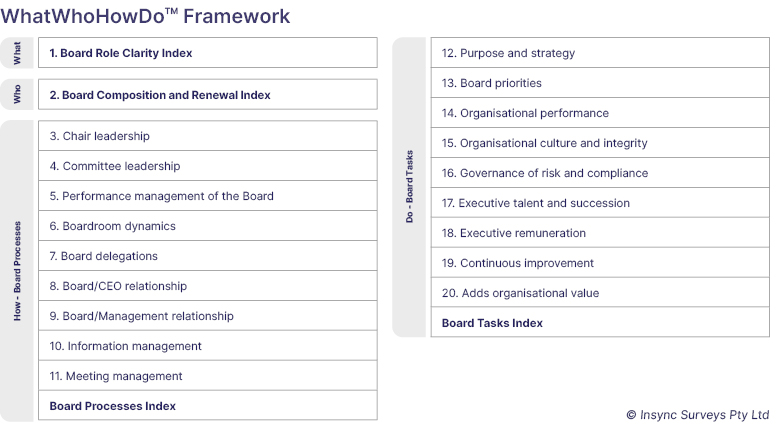New ground-breaking validated research conducted by Board Benchmarking with the assistance of Deakin University reveals that board roles are much more complex than previously thought.
Many researchers, practitioners and governance experts thought that there were around 10 main areas in which boards needed to excel to be highly effective. The new research shows that there are 20 discrete areas which contribute to the effectiveness of boards and the new research has also identified exactly what those 20 areas are.
Boards can be great at certain aspects of their roles but if they are not proficient in most, if not all of the 20 discrete areas that impact their effectiveness, they are likely to let down themselves and their organisation.
For example, your board members can have all the right skills and attributes but they just may not work together well. A team of champions, for example, won’t always gel together to create a champion team.
If you gel as a team and don’t have a robust relationship with the CEO and management that won’t work well either.
You can gel well as a team and have great relationships with the CEO and management but if the hard work of strategy, oversight of culture and risk management is not done well the board will fail to be effective.
And these real life examples go on and on.
How the research was conducted?
Board Benchmarking developed a world class benchmarked Board Effectiveness Survey over 10 years ago with the help of local and global governance experts, KPMG Australia and many experienced directors.
That survey has since been used as part of a process to review the effectiveness of in excess of 250 boards of organisations in Australia, New Zealand and Mauritius, including a large range of clients of Insync, KPMG Australia, Gerard Daniels, Westlake Governance in New Zealand and BDO in Mauritius. The boards reviewed include many listed, private, government and not-for-profit organisations including several large banks, airport, land and treasury corporations, universities, health networks and hospitals, health care, mining, resources and construction companies, insurance, superannuation, funds management and service companies, retailers, a zoo, water authorities, numerous mutual banks and credit unions, schools and not-for-profit organisations.
A comprehensive review of the benchmarked Board Effectiveness Survey was completed in 2020 with the assistance of Deakin University. The review included a psychometric and statistical analysis, a detailed literature review and input from several practitioners and governance experts. The early part of Deakin’s research was published in Frontiers in Psychology in November, 2018 in an article titled, Boards of directors: Assessing their functioning and validation of a multi-dimensional measure.
The research identified 20 discrete areas (factors) of board effectiveness and the most appropriate matters, and therefore the survey items that should be included with each factor. A greater focus was also added to some of the more recent measures of a board’s effectiveness including organisational culture and integrity, organisational purpose, crisis management and a better prioritisation of the board’s time.
WhatWhoHowDo Framework
The newly researched 20 discrete factors of a board’s effectiveness continue to fit well within Board Benchmarking’s world class WhatWhoHowDo framework for board effectiveness.
The images below are an extract from a benchmarked Board Effectiveness Report that has been redesigned to include the newly researched survey items that fit the 20 discrete factors of a board’s effectiveness.
This is how this sample board is benchmarked against comparable organisations. Where do you think your board would be benchmarked overall and on each of the 20 discrete factors of a board’s effectiveness? You can find out be completing one of Board Benchmarking’s affordable Board Effectiveness Surveys.

This is how this sample board is benchmarked against comparable boards in each of the 20 most important areas of a board’s effectiveness.

The 20 factors of a board’s effectiveness are explained in detail below.
Because many of these factors manifest themselves “behind closed doors” and because little is known about the effectiveness of boards at some of these processes, benchmarking using one of Board Benchmarking’s validated surveys, supplemented by periodic interviews by experienced governance experts, can help boards more easily understand their effectiveness in each of the 20 areas.
What – 1. Board role clarity
Board members should demonstrate a clear understanding of their role as being that of governance, to provide oversight and to add value. Importantly board members will also understand how their role differs from that of management and will act accordingly. There should be appropriate documentation of the role of the board, the Chair and of individual board members as well as of committees and the committee chair.
Who – 2. Board composition and renewal
The size of the board should be appropriate to the circumstances, the process for recruiting new directors needs to work well and new directors need to receive a comprehensive induction. The board should have the appropriate diversity and ongoing renewal, including succession plans for the Chair, committee Chairs and the addition and/or replacement of important skills and experiences. Importantly, board members and the members of each committee will have the abilities, skills and experience that match the current and future strategic needs of the organisation and of the relevant committee.
How – Board processes
How a board comes together to address issues and make decisions is a critical determinant of its effectiveness. How boards act — or fail to act — is a complex interaction and the result of the nine factors set out in this section.
These factors include hard and soft elements of “Board Process” or the “How” the board carries out its tasks. If a board has good processes it will significantly assist the board to carry out its task (the Do) well.
How – 3. Chair leadership and effectiveness
The board is unlikely to be effective if it doesn’t have an effective Chair. This section considers the extent to which the Chair sets high standards, exercises sound business judgement and drives key priorities. Whether the Chair builds healthy boardroom dynamics, conducts an effective decision making process, ensures that discussions don’t get side tracked from key issues and is respected and trusted by all directors are also considered.
How – 4. Committee leadership and effectiveness
Board committees should be used effectively to support the work of the board, including by spreading the board’s workload effectively. Committee chairs need to be effective in their roles, including by setting clear agendas and clear expectations of management and providing useful reports and recommendations to the board. The effectiveness of committee Chairs in communicating with the board and ensuring they have a positive working relationship with the relevant members of management is also considered.
How – 5. Performance management of the board
It is important that the board acts independently of management with board members and committees forming their own judgements and expressing their own opinions. Appropriate action should also be taken if there is an unsatisfactory commitment or performance or undesirable or questionable behaviours by a board member. Good performance management of the board will also ensure that time is carved out to assess the effectiveness of the Chair and committee Chairs as well as individual directors.
How – 6. Boardroom dynamics
It is important that the board works constructively as a team and that boardroom discussion are constructive, with directors disagreeing without being disagreeable. The extent that directors communicate well and feel free to speak out openly and honestly without fear of criticism, even when voicing a minority position is also considered. It is also important that directors value and respect each other’s contributions.
How – 7. Board delegations
Determining the views of both board members and executives as to whether the extent of the financial and non-financial authority delegated by the board to management and committees is appropriate is important. Management should also be clear about what matters must be referred to the board or to a board committee, whether that be for approval, for endorsement or for information.
How – 8. Board/CEO relationship
It is unlikely that a board will be effective if the chair does not have a constructive working relationship with the CEO which is supportive, collaborative, yet independent. The board should also display confidence in the overall performance of the CEO and the CEO’s performance should be managed effectively on behalf of the board with the appropriate input being provided by all directors.
How – 9. Board/Management relationship
The board and management should have effective working relationships that are collegial, respectful and with an independence of thought. It is also important for the board to have robust discussions with management that go into the appropriate detail. The board should provide clarity of direction to management and management should promptly communicate bad news to the board. Good boards will also enhance management’s thinking and decisions with appropriate reflections, advice, encouragement and constructive challenge.
How – 10. Information management
It is important that the board receives the relevant, clear, concise, timely and forward-looking information it needs in the appropriate format. This will include appropriate information on the organisation’s performance and with important strategic issues presented to the board with adequate time for reflective thought. Board member requests for information should also be handled well.
How – 11. Meeting management
Discussion time during board meeting should be maximised with management not unnecessarily repeating what board members have already read in board papers. Management’s involvement in board meetings should contribute to the board’s effectiveness and the board’s in-camera sessions (without the MD, CEO or management) should be effective. The company secretary, or equivalent, will assist the board to fulfil its responsibilities and there will be clear written and verbal reporting from committees.
Do – Board tasks
The Do describes what the board does in terms of its main tasks.
If the board carries out its most important tasks well it can significantly enhance the organisation’s overall performance and its sustainability as well as protect and enhance its reputation. If the board does not meet some or all of these fundamental responsibilities the organisation will almost certainly suffer as a result.
Do – 12. Vision and strategy
The board and management should be committed to a common vision and purpose for the organisation with the board setting the broad parameters for management to prepare the strategic plan. This section will all consider whether the board takes into account the “big picture” external factors that may influence the organisation’s performance and the extent that the board understands the key drivers affecting the organisation’s performance. Also, the board should only approve the strategic plan after conducting a rigorous review.
Do – 13. Board priorities
Ensuring that the board spends most of its time on the most important issues is not as easy as it sounds. Nor is ensuring that the board spends an appropriate amount of time on the matters that are likely to make the biggest difference to the organisation over the next five years. It requires boards to be aligned around their main priorities and objectives for the year ahead. The board will carve out time during the year to do deep dives into the most important issues, focus sufficiently on the success of major projects and ensure that its meetings have the right balance of strategic, performance and compliance matters.
D0 – 14. Organisation performance
A strong performance focus starts with the board and management having a shared commitment to the measures used to track that performance and then ensuring the organisation has an effective performance management system with agreed accountabilities that are cascaded down through the organisation. The board will encourage a strong culture of performance which will include appropriate benchmarking, challenging goals and ensuring appropriate action is taken when performance measures are not met.
Do – 15. Organisation culture and integrity
The board should set a high tone at the top in relation to the organisation’s culture, ethics and integrity and take an appropriate role in shaping the organisation’s culture. This will include identifying and driving any cultural change required. Effective processes should also be in place to actively manage any actual or perceived conflict of interest. The board should also ensure that stakeholder management is handled well and that there are effective governance procedures in place to protect the employment and health and safety rights of employees.
Do – 16. Governance of risk and compliance
Whilst it is difficult to anticipate every contingency the board and management should be well prepared to handle a crisis. The board and management should have an agreed view on the organisation’s appetite for risk and ensure that the organisation has a comprehensive and effective risk management system that is appropriate to its circumstances. The board should also ensure that the organisation has effective compliance procedures, an effective internal control system and that it receives appropriate information on how the organisation’s risks are managed. Overseeing the risk of cyber-attacks and the loss of customer and other sensitive data is also critical in the current environment.
Do – 17. Executive talent and succession planning
Quite a few boards need to take a more active role in overseeing the growth in the organisation’s leadership talent pool by overseeing the identification, attraction, motivation, development and retention of talent. Boards should also ensure that there are appropriate succession plans in place for the CEO and key management roles.
Do – 18. Executive remuneration
It is important for the board to ensure that the CEO has an appropriate remuneration package which is well structured, in line with the market and with any incentives based on well documented criteria. The board should also ensure the same applies for key management personnel other than the CEO.
Do – 19. Continuous improvement
The board should regularly review its overall effectiveness and how it can improve. This will include searching for fresh, new ways to consider problems and being open to changing the way it operates in order to be more effective. All directors should also keep abreast of new developments and innovations through self study and training provided by the organisation.
Do – 20. Add organisational value
It is important for the board to provide good governance and oversight but ultimately it needs to ensure that it adds organisational value in as many ways as it can, including to the organisation’s performance, sustainability and reputation.



